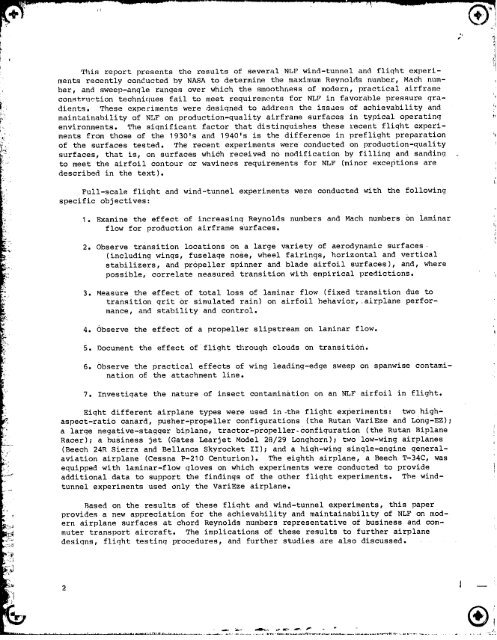NASA Technical Paper 2256 - CAFE Foundation
NASA Technical Paper 2256 - CAFE Foundation
NASA Technical Paper 2256 - CAFE Foundation
You also want an ePaper? Increase the reach of your titles
YUMPU automatically turns print PDFs into web optimized ePapers that Google loves.
This report presents the results of several NLF wind-tunnel and flight experi-<br />
ments recently conducted by <strong>NASA</strong> to determine the maximum Reynolds number, Mach num-<br />
ber, and sweep-angle ranges over which the smoothness of modern, practical airframe<br />
construction techniques fail to meet requirements for NLF in favorable pressure gra-<br />
dients. These expeciments were designed to address the issues of achievability and<br />
maintainability of NLF on production-quality airframe surfaces in typical operating<br />
environments. The significant factor that distinguishes these _ecent flight experi-<br />
ments from those of the 1930's and 1940's is the difference in preflight preparation<br />
of the surfaces tested. The recent experiments were conducted on production-quality<br />
surfaces, that is, on surfaces which received no modification by filling and sanding<br />
to meet the airfoil contour or waviness requirements for NLF (minor exceptions are<br />
described in the text).<br />
Full-scale flight and wind-tunnel experiments were conducted with the following<br />
specific objectives:<br />
I. Examine the effect of increasing Reynolds numbers and Mach numbers on laminar<br />
flow for production airframe Surfaces.<br />
2. Observe transition locations on a large variety of aerodynamic surfaces<br />
(including wings, fuselage nose, wheel fairinqs, horizontal and vertical<br />
stabilizers, and propeller spinner and blade airfoil surfaces), and, where<br />
possible, correlate measured transition with empirical predictions.<br />
3. Measure the effect of total loss of laminar flow (fixed transition due to<br />
transition grit Or simulated rain) on airfoil behavior, airplane perfor-<br />
mance, and stability and control.<br />
4. Observe the effect of a propeller slipstream on laminar flow.<br />
5. Document the effect of flight _%rough clouds on transition.<br />
6. Observe the practical effects of wing leading-edge sweep on spanwise contamination<br />
of the attachment line.<br />
7. Investigate the nature of insect contamination on an NLF airfoil in flight.<br />
Eiqht different airplane types were used in-the fligh t experiments: two high"<br />
aspect-ratio canard, pusher-propeller configurations (the Rutan VariEze and L0ng-EZ);<br />
a large negative-stagger biplane, tractor-propeller-confiqurati0n (the Rutan Biplane<br />
Racer); a business jet (Gates Learjet Model 28/29 Longhorn); two low-wing airplanes<br />
(Beech 24R Sierra and Bellanca Skyrocket II); and a high-wing single-engine general-<br />
aviation airplane (Cessna P-210 Centurion). The eighth airplane, a Beech T-34C, was<br />
equipped with laminar-flow gloves on which experiments were conducted to provide<br />
additional data to support the findings of the other flight experiments. The wind-<br />
tunnel experiments used only the VariEze airplane.<br />
Based on the results of these flight and wind-tunnel experiments, this paper<br />
provides a new appreciation for the achievability and maintainabillty of NLF on mod-<br />
ern airplane surfaces at chord Reynolds numbers representative of business and com-<br />
muter transport aircraft. The implications of these results to further airplane<br />
designs, flight testing procedures, and further studies are also discussed.<br />
2<br />
,<br />
®

















